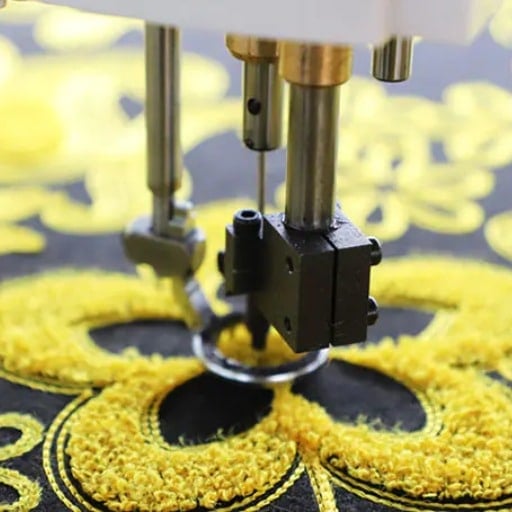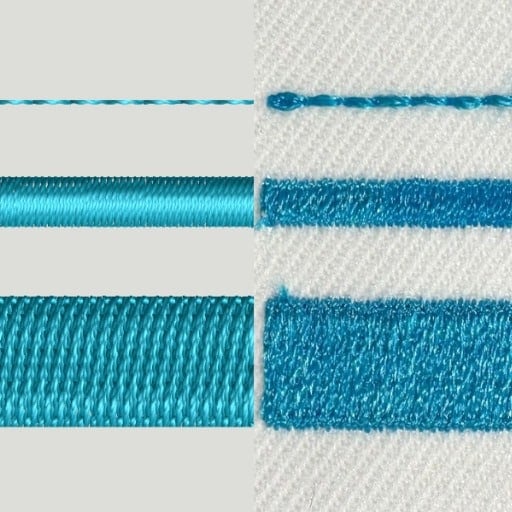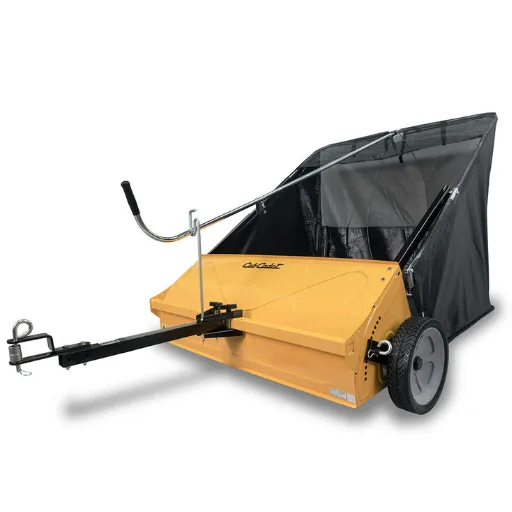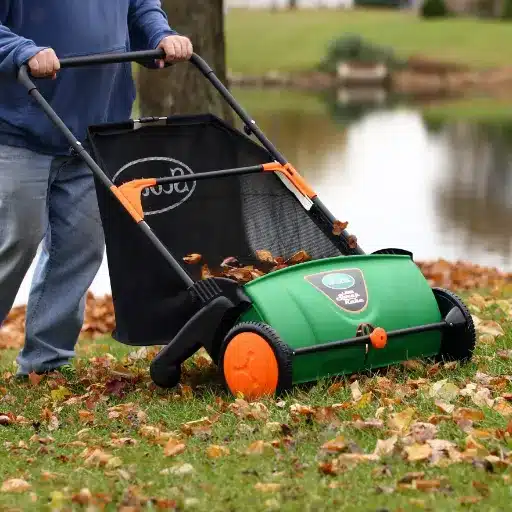Machine embroidery is an interesting course for many, but it can also be quite daunting for beginners. In life, every art has its tricks and tips; in this case, we’ll explore them together. This chapter will focus on the basic stitches that are a prerequisite for stitching more intricate embroideries. Understanding what they are, how they’re made, and what they achieve will be the highlight of the discussion. Equally so, this chapter will also provide helpful pointers to factors like the type of fabric, thread, and stabilizers that are acceptable and how they can be flawlessly put into practice. We’ll go step by step as we reveal the methods of how to thread and operate an embroidery machine; this will help build confidence and reinforce the ability to make the first patterns. When following this guide, you will acquire all of the essential insights in order to make sure some of the embroidered pieces you will create will be beyond the normal standards, thus preparing for your imaginative adventure with the use of machine embroidery.
What are the Different Machine Embroidery Stitching Types?

To embark on your machine embroidery journey, it’s essential to become acquainted with the different types of stitches that form the basis of your designs. Here are some of the fundamental embroidery stitch types:
- Straight Stitch: The most basic stitch type, it creates simple lines and outlines. It’s versatile for fine details and defining shapes within a design.
- Satin Stitch: Often used for lettering and filling in small areas, the satin stitch provides a smooth, glossy finish that stands out in designs.
- Fill Stitch (or Tatami Stitch): Used to fill large areas, this stitch type consists of rows of stitches laid side by side. It can be adjusted in density for different textures and appears as a smooth, even surface.
- Running Stitch: Similar to the straight stitch but used for outlines, it’s a quick stitch that involves intermittent spaces between the stitches, useful for tracing designs and fine details.
- Zigzag Stitch: As the name suggests, this stitch forms a zigzag pattern and is typically used for decorative borders or as a base layer for denser stitches like the satin stitch.
Understanding these basic stitch types is crucial, as they serve as foundational elements that you’ll regularly employ in your embroidery projects. As you practice, you’ll learn to manipulate these stitches to achieve a wide range of creative effects.
Understanding Basic Embroidery Stitches
It seems to me that an understanding of the basic stitches in embroidery must include some grasp of the variety of types there are, from the straight stitch, which allows me to create outlines and details with precision, to the satin stitch, which gives a more clean-seamed finish that is great for lettering and small areas. The fill stitch is very important in my work because it comes in handy when it is necessary to fill in a bigger area and provides me with the opportunity to control the texture and density of the design. Even the running stitch has its place, which allows me to outline designs with speed, while the zigzag stitch gives border decoration or reinforcement. As I learn how to work with these stitch types, I realize that this will enable me to work more freely and creatively on my embroidery exercises.
Exploring Advanced machine embroidery stitching
You should be aware that chain embroidery stitch has so many applications. First, the aesthetic value of these stitches can enhance any project greatly. A feather stitch, for example, improves the appeal of nearly any floral motif because of the interlaced character of the stitch. When learning how to do a stipple stitch, I realized that it is good to use it on any exposed areas around the main focus, not splashing chaos on the primary elements. With the ability to understand these different stitches, one is able to play around a bit more, turn out pieces with a professional feel, and add a distinctive character to each work that I make.
Choosing the Right Embroidery Stitch Types for Your Project
As I choose the various types of embroidery stitches for my project, I take into consideration the complexity of the design, the type of fabric, and the texture I want to achieve. I noticed that for thin fabrics like silk, applying thinner stitches like running stitches or small satin stitches helps to limit the deflection on the fabric. As for thicker fabrics, stronger stitches like fill stitch or chain stitch create beauty and strength. Other parameters related to the seam, like stitching length and tension, also matter: for example, when I construct curves, I feel that a short seam of 1–2 mm is suitable. However, when making straight lines, I prefer longer stitches on the order of 3–4 mm, which brings the desired results. Proper regulation of stitch density for the work objects is important; for example, low densities are suitable for stitching detailed designs, whereas high densities are for solid areas. This guarantees that I will be able to correctly achieve the desired effects on each project I work on.
How Does an Embroidery Machine Work?

The embroidery machine operates by sewing designs on any fabric design by using a combination of hardware and software. The machine comprises several important components, which include a needle, bobbins, and an embroidery hoop, which helps to hold the fabric in place. Typically, an image that is to be embroidered is first created on a computer using embroidery software that converts the design into a form that the machine can read. A number of cords anchored to a computer are capable of guiding the needle and the thread stirring in a designated location once the appropriate design is placed in the machine. Users pick the desired stitch types, patterns, colors and threads tension while the machine does precisely the opposite, the embroidery is illustrated through a needle which is controlled by a thread jump that precisely moves the fabric on the embroidery where stitches are placed. The end result of this process is, therefore, an embroidery that is accurately embroidered in the same manner as intended.
Components of a Sewing and Embroidery Machine
Needle and Thread
The needle and thread are crucial components of any sewing and embroidery machine. The needle is responsible for punching through the fabric, while the thread gives color and detail to the design. It’s important to use the appropriate needle size and thread type for the fabric and design to ensure smooth operation and high-quality results.
Bobbin
The bobbin plays a key role in feeding the thread underneath the fabric, which helps form stitches. Ensuring the bobbin is correctly wound and inserted will prevent snags and interruptions during the embroidery process.
Embroidery Hoop
The embroidery hoop holds the fabric taut, which is essential for precise stitching. Keeping the fabric steady allows the machine to accurately follow the design patterns, reducing errors and enhancing the final appearance of the embroidery.
Computer Interface and Software
Many modern machines come with a computer interface that allows me to upload and customize designs. Using specialized software, I can manipulate stitch styles, sizes, and colors to suit my aesthetic preferences. This flexibility is invaluable in personalizing each project to meet specific needs.
Stitching Motor
The stitching motor is responsible for driving the needle and coordinating the machine’s functions. A smooth-operating motor ensures that the machine runs quietly and efficiently, supporting complex and detailed embroidery work without interruptions.
Using Embroidery Software to Digitize Designs
Defines embroidery as “the craft of decorating fabric or other materials using needle and thread or yarn.” What if I told you that this work may be simplified using software? It’s all about combining art with technology. Using embroidery software is easy; it’s a matter of following a few steps. First of all, there are a lot of possibilities with regard to digitizing design, the software is quite flexible—it allows you to import your choice of design which has a range of file types enabled. Then I have to edit the appropriate design so that it covers all thread color options and select different types of stitching, for me to be assured that it will come out the way I want. The best thing about this software is that it gives me design suggestions, allowing me to see how the design would look after sewing. Other manipulating factors, such as size and position, can also be altered depending on the owner’s preference. When all is done, I save the artwork and output it into the editing software that is compatible with my sewing machine, which, in a way, bridges the art with the technology, giving the creator precision.
Loading Machine Embroidery Designs via USB
At the start of the machine embroidery process, when I want to load my digitized designs, I plug a USB stick into the port, which contains all of my designs. First and foremost, I make sure that the files I have are saved in a format my embroidery machine can use. These could be.PES or.DST. Then I put the USB in and start looking for the file on the machine screen, I go to external storage. I direct the required design files and move them to the machine’s memory. It is also necessary to check the user manual of the embroidery machine for the technical parameters, including the maximum size of the file, supported formats of the USB drive, and so on. Also, maintaining the files on the USB stick in an orderly manner helps to ease the process, making it easy to locate and pick the required files during the loading.
What are the Best Practices for Machine Embroidery?

In order to achieve the best results in machine embroidery, there are certain principles that should always be followed. First of all, it is necessary to always utilize good quality threads and stabilizers since these supplies contribute significantly to the overall quality and strength of your embroidery work. It is also important to do correct hooping; the garment should be stretched and flattened in the hoop adequately so that the fabric does not pucker and the stitches do not get misaligned. It is easy to forget to clean the embroidery machine and its parts, such as the needle, but this routine is very important for the normal functioning of the machine and for avoiding thread breakage. When choosing designs, mesh type and thickness should be taken into account to avoid stretching the fabric. Finally, similar materials can be used for test runs so that settings can be adjusted and problems can be sorted out before making the final workpiece. If such guidelines are followed, the machine embroidery projects will be of better quality and greater visual appeal.
Proper Thread and Needle Selection
To select the right thread and needle for machine embroidery, my first priority is to team the thread type with the fabric and design specifications. It is advisable to use threads made out of polyester or rayon for stitching as they are strong and cut in a variety of colors. I also make sure that the needle chosen is suitable for the size of the thread relative to the fabric, choosing a needle for embroidery that has a wide eye for the thicker threads. Referring to the embroidery needle chart helps me select the size of the needle I will use and, in doing so, protect the fabric while trying to obtain the best quality stitches. Given these considerations, I improve my projects in terms of cosmetics and their solidity.
Using a Hoop and Stabilizer Effectively
To begin with, I make sure that the fabric in the hoop is not slack but not stretched, as it could potentially alter the design when I use a hoop and stabilizer. As some embroidery practitioners put it onto the net, most importantly, picking the right stabilizer is specific to the type of fabric and the design specifications. For example, a cut-away is best for stretchy fabrics, while a tear-away would be suitable for stable fabrics. To guard against such issues as fabric and stabilizer misalignment, I always make sure to mount them correctly. Using an incorrect hooping technique with an incorrect stabilizer can cause degraded quality of stitches and a number of problems such as puckering and visualization distortion, in general adding more complexity to the stitching process. Following these guidelines allowed me to achieve satisfactory results in my embroidery works, with embroidery being of professional grade.
Tips for Embroidery Work Quality
You know, it is not easy being an embroiderer. There are a number of challenges one must overcome and aspects to take care of, and I would know best since it is something I have perfected over the years. Firstly, maintaining thread tension is a must, as it ensures there are no loops or breaks in the thread when stitching the fabric together. Tension settings usually vary from 2.0 to 4.0, but it is advisable to comment on them with the machine’s manual to get the most optimal settings. Secondly, I use only the best threads that do not get tangled, deform, or lose color. Thirdly, in order to get the best stitches, it is of utmost importance to keep the embroidery machine clean and oiled. Last but not least, on a frequent basis, calibrating the machine and adjusting the hoop can do wonders for the embroidery. Overall, if these strategies are implemented correctly, one can easily produce professional-looking embroidery.
How Can Beginners Master Machine Embroidery Stitching?

With the shot guidance and practice, both novice and experienced practitioners can start learning about various techniques while focusing on machine embroidery stitching. To begin, they need to understand the machine and its settings, working, and maintenance. Such a technique helps a novice to learn the targeted tensions and desired stitch density while stitching different types of stitches on a mocked-up fabric, which helps in hands-on learning. Similarly, starting with easier stitches to overcome confidence issues and moving on to complex designs becomes useful. Such insight is available in depth in the tutorials and forums that offer valuable tips and troubleshooting advice. Lastly, it should be emphasized that sewing and skills develop with time, along with patience and practice.
Learning Embroidery Basics for Beginners
As a beginner in embroidery, I started by focusing on understanding my machine deeply by reading the manual and watching instructional videos. For starters, practicing straightforward stitches on a mocked-up fabric made it easier for me to adapt to different tension levels and stitch density. With the experience gained, I was also able to get access to tutorials and online forums where users discuss challenges and offer tips and solutions. This made me understand and appreciate sewing one type of stitch at a time before trying out several at once and ending up wasting fabric for nothing. With perseverance, I continued making practice a priority, and this improved the quality of my work and my confidence when working with more complex patterns.
Practicing Embroidery Designs and Patterns
For starters, it is advisable to look for uncomplicated designs on the internet as they make it easier to learn how to embroider. I also use a hoop, which aids greatly in clutching my fabric with tautness so that the stitches are even throughout the embroidery process. Threads that are of good quality are recommended in order to produce an efficient finish and ensure that tangling is avoided. Along with working on my creative skills, I apply time to practical aspects and work on my different stitching techniques. That said, most of the time I follow different procedures aimed at assisting me in solving any problems that arise during the joining of certain seams. With those measures, I’ve had amazing growth in my sewing techniques, and I am pleased with how well embroidery helps me with my creativity.
Common Mistakes to Avoid in Beginner Embroidery
The first mistake I made in embroidery was not stabilizing my fabric properly whenever I worked on an embroidery, which caused puckers, and worse, my designs were deformed in the process. Fabrics and designs often require specific tension, and therefore, the correct stabilizer should always be used. Also, I understood how crucial it was to select the correct thread and needle. Choosing the wrong materials will increase the chances of thread breaking or having uneven stitches. In addition, I was also reminded that the importance of proper hooping should never be underrated, as poor positioning of the fabric can lead to poor embroidery techniques. And since I did not have the habit of cleaning my machine or servicing it, I started experiencing a lot of uninvited problems meaning I needed to make servicing a routine activity. Awareness of such technical aspects has helped me remarkably advance my embroidery outcomes.
How to Choose the Right Sewing Patterns for Machine Embroidery?

When making choices on machine embroidery design patterns, there are more than a few things to think about. Start off by looking at the construction level of the chosen design. Simple patterns with less than three colors and types of stitch would suit an amateur embroidered, but those with a lot of experience might go for floral or geometric patterns. Look at the size of the design, which fits the scale of your project as well as that of your embroidery machine. The type of fabric used is equally important. Choose patterns that fit the type of fabric to avoid distortion. Last but not least, if you are using a commercial pattern, check what other users are saying about the ease or difficulties in modifying the pattern. When these requirements match your skills and the plans for the embroidery, you will be able to choose the patterns that will improve not only the process of embroidering but also the end result.
Matching Embroidery Designs with Fabric
While combining fabric and embroidery designs, I keep in mind the fabric’s texture and weight. For example, silks and light chiffon should go with finer and lighter designs to avoid puckering. On the other hand, there are heavier fabrics like denim or canvas that can accommodate bold embroidery without complications. Moreover, I make sure that the thread color works consonantly with the fabric color in order to enrich the final design. Furthermore, I also consider the stretchability of the fabric; when working with stretchy fabric, I microwave the designs to some amount of stretch to avoid distortion once the fabric is worn or washed. Lastly, I also look at the general function of the embroidered piece and select embroidery that is suitable so that imagination is combined with practicality.
Understanding the Impact of Different Stitches on Patterns
Gaining an appreciation of how various stitches affect the design patterns should include a realization that varying the stitching style may dramatically change the feel and look of your design. Based on what I have seen and worked with, satin stitches seem to offer a glossy and silky touch, which is usually ideal for thick borders and filling bigger spaces in a pattern. We are fortunate in embroidery in that there is a nice variety of interesting stitches, and a simple running stitch would suffice to achieve the desired distinctive outline or fine lines. Decorative stitches such as chain or cross stitch that I have used do present a different decorative feel, although more practical, and are more predominant in folk and traditional designs. More importantly, the type of fabric and stitch tension should also be taken into account since they are likely to have an effect on the properties and overall quality of the finished embroidered item.
Customizing Embroidery Stitch Types for Unique Projects
The embroidery stitch type selections for the various projects should be such that they help to maintain the distinctiveness and the purpose of each piece. I have noted that it is very important to try and choose the right stitch type (for example, satin, running, and decorative stitches) because it changes the overall look and feel of the design. For example, parameters like stitch length and width with satin stitches will result in smooth and bold fills ideal for the satin stitch. However, running stitches are slightly more complex as they create more delicate details; however, they require the perfect tension control. The use of embroidery decorative stitches allows for the use of stitches in designs that are more textured as they are less fragile. When achieving this, it is important to change the stitch density, taking into consideration factors like the fabric type to be used and the function of the embroidery; this is to preserve the beauty and functionality of the piece. With regard to these considerations, it is easier to reason that each embroidery work is well thought out and created with both practicality and innovative ideas.
References
-
Karlie Belle – Beginner Machine Embroidery Supplies: This provides a list of essential supplies needed to start machine embroidery, which is useful for beginners.
-
Tough Kitten Crafts – Machine Embroidery 101 For Beginners: Offers a comprehensive guide on the tools and materials needed for machine embroidery.
-
Crafty Life Mom – Getting Started with Machine Embroidery: Provides tips and advice on how to begin your machine embroidery journey.
Frequently Asked Questions (FAQ)
Q: What are the three main types of machine embroidery stitching?
A: The three main types of machine embroidery stitching are satin stitch, fill stitch, and running stitch. Each of these stitches serves a different purpose and can be used to create various designs on your garment or quilt.
Q: How does a sewing machine execute a satin stitch?
A: A sewing machine executes a satin stitch by closely placing a series of stitches side by side to form a smooth, shiny line. Satin stitches are used to create outlines or details in a design, and they are ideal for creating letters and borders.
Q: What is the purpose of fill stitches in machine embroidery?
A: Fill stitches are used to cover large areas of a design. They are made up of rows of stitches that weave together to fill in the spaces, making them perfect for creating solid shapes and backgrounds in embroidery.
Q: Can you explain what a bean stitch is in machine embroidery?
A: A bean stitch, also known as a triple stitch, is a type of running stitch where the sewing machine stitches back and forth over the same line three times. This creates a thicker, more pronounced stitch that is great for outlines and accents.
Q: What role do underlay stitches play in machine embroidery?
A: Underlay stitches are used to stabilize the fabric and create a foundation for the main embroidery stitches. They help prevent fabric puckering and ensure that the top stitches look smooth and even. Underlay stitches are crucial for achieving high-quality embroidery results.
Q: How can a beginner start with basic machine embroidery?
A: A beginner can start with basic machine embroidery by learning about the different machine embroidery stitch types and practicing with simple designs. Using digitizing software can help create custom patterns, and watching tutorials on platforms like the world on YouTube can provide valuable embroidery knowledge to get started.
Q: What is the difference between a straight stitch and a zigzag stitch in machine embroidery?
A: A straight stitch is a basic stitch that goes in a straight line and is commonly used for outlining designs. A zigzag stitch, on the other hand, moves in a back-and-forth pattern and is often used for creating decorative elements or attaching appliques to fabric.
Q: Why is it important to use fewer stitches in certain parts of a design?
A: Using fewer stitches in parts of a design can prevent fabric distortion and reduce stiffness in the embroidered area. It is especially important in areas where flexibility is needed, such as on apparel, to ensure comfort and wearability.









